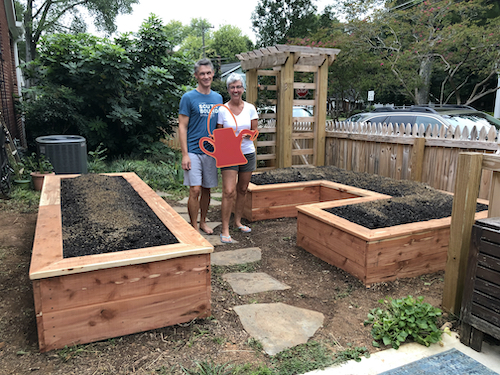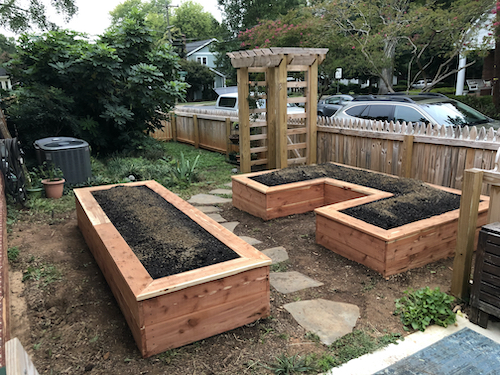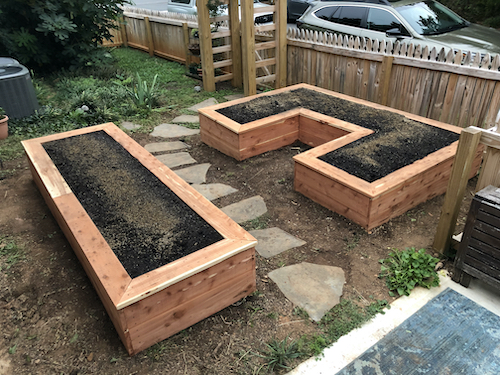Goodbye Sore Backs, Hello Kitchen Garden
 Tuesday, January 4, 2022 at 10:14AM
Tuesday, January 4, 2022 at 10:14AM 
William and Elizabeth McKee have a cheerfulness and contagious optimism that could thaw half of Siberia. And it’s no surprise that when disease finally forced the removal of two colossal shade trees on the couple’s Chantilly property, they quickly separated the silver lining from the understandable disappointment. Areas of the their yard that once nurtured delicate, shade-loving ornamental plant varieties, were now opened up to hours of direct sunlight. So the McKee’s decided to plant an organic garden.
And the site that they selected for their new garden had all the key advantages that we look for when choosing an edible garden site; Plenty of sunlight. A water supply nearby. And a very short walk to the kitchen. With these essential considerations working in their favor, plus a worthy effort with a garden hoe and lots of organic compost, an area along the left side of their home became an organic garden. Tomatoes and peppers thrived there, proving that there was, indeed, more than enough sunlight to grow any edible variety, even heat-loving summer vegetables.
But that success was hard-earned and came at the expense of the perpetual struggle against a stubborn clay soil that resisted attempts to improve drainage and aeration, swallowing up compost and other organic soil amendments, with only modest improvements in soil quality to show for it.
By the end of the summer, two sore backs and a sprawling, weed-choked garden seemed to cry out together, “ There has to be a better way!”
There is a better way, and the McKee’s soon discovered that cedar raised beds were the answer. After searching around for the right raised bed design - carefully reviewing raised bed kits, and other raised beds of various style and construction - they at last selected our 18”- tall Kitchen Garden raised bed design. All that hacking away in vain at a churlish slab of clay was finally disappearing in the rearview mirror.
The Kitchen Garden is made with aromatic red cedar - a naturally durable wood that’s famously long lasting in outdoor projects like raised beds, chicken coops, greenhouses, and compost bins. Red Cedar’s well-founded reputation for resistance to insects and decay is no trendy exaggeration; it’s been well-earned over the eons of this special tree’s service to humanity.
The McKees’ organic garden features two raised beds. One is a U-shaped Kitchen Garden that measures 3’ wide, 9’ across the back and 6’ long on the sides. Just across the flagstone pathway sits a 3’x 9’ Kitchen Garden raised bed.

One of the key advantage of the 18” height of the kitchen garden is the reduced wear and tear on a gardener’s body. With its sturdy seating cap placed at the standard height of a chair or bench seat, the Kitchen Garden design makes it easy to relax and tend your garden.
Another key advantage of the 18” height of the Kitchen Garden design is the large volume of premium organic soil available to nourish plants. Like all of our Kitchen Garden raised beds, the McKee’s new raised beds are filled with a lightweight organic soil blend that allows water to easily drain through, helping avoid the problems that come along with perpetually soggy soil. This special horticultural grow media is a blend of mushroom compost, shredded pine bark fines, and slate pebbles, and allows plant roots to quickly grow through the soil, and take in air and nutrients.
And it was an easy decision to add drip irrigation to the garden. Both William and Elizabeth work full time, and they heartily appreciated the amount of time the automated drip irrigation watering system will save. Both raised are fitted with grids of 1/2” drip tubing, with emitters spaced 12” apart, and that each deliver about a gallon of water per hour. These irrigation grids are buried a few inches below the soil surface, which conserves water by delivering it right to the plant root zone. In raised beds, this buried-drip irrigation method is far preferable to above- ground irrigation sprayers that often put too much water on the plant foliage instead of the roots. Above-ground irrigation sprayers tend to keep plant foliage perpetually wet, encouraging fungal diseases in edible plant varieties, and potentially scalding plants and wasting water through evaporation on hot days. The drip tubing in both raised beds is connected underground and routed to the nearby spigot, where watering is controlled by a battery-powered timer.

With the raised beds leveled, staked down, and filled with organic soil, and the automated drip irrigation system programmed, it’s time for the McKees to start planting. And what does the future hold for Elizabeth and William’s new garden? Tasty organic produce? Fresh air and sunshine? New gardening adventures together? Surely all this and more.
But the sore backs and the clash with clay are finally a thing of the past.








Reader Comments